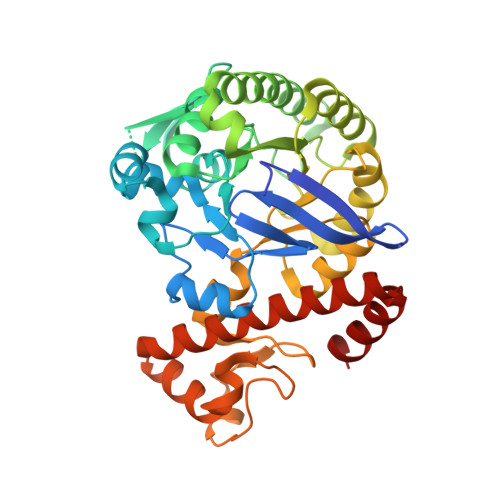Glutamate versus Glutamine Exchange Swaps Substrate Selectivity in tRNA-Guanine Transglycosylase: Insight into the Regulation of Substrate Selectivity by Kinetic and Crystallographic Studies
Tidten, N., Stengl, B., Heine, A., Garcia, G.A., Klebe, G., Reuter, K.(2007) J Mol Biol 374: 764-776
- PubMed: 17949745
- DOI: https://doi.org/10.1016/j.jmb.2007.09.062
- Primary Citation of Related Structures:
2OKO, 2POT, 2PWU, 2PWV, 2QII, 2Z1V, 2Z1W, 2Z1X - PubMed Abstract:
Bacterial tRNA-guanine transglycosylase (Tgt) catalyses the exchange of guanine in the wobble position of particular tRNAs by the modified base preQ(1). In vitro, however, the enzyme is also able to insert the immediate biosynthetic precursor, preQ(0), into those tRNAs. This substrate promiscuity is based on a peptide switch in the active site, gated by the general acid/base Glu235. The switch alters the properties of the binding pocket to allow either the accommodation of guanine or preQ(1). The peptide conformer recognising guanine, however, is also able to bind preQ(0). To investigate selectivity regulation, kinetic data for Zymomonas mobilis Tgt were recorded. They show that selectivity in favour of the actual substrate preQ(1) over preQ(0) is not achieved by a difference in affinity but via a higher turnover rate. Moreover, a Tgt(Glu235Gln) variant was constructed. The mutation was intended to stabilise the peptide switch in the conformation favouring guanine and preQ(0) binding. Kinetic characterisation of the mutated enzyme revealed that the Glu235Gln exchange has, with respect to all substrate bases, no significant influence on k(cat). In contrast, K(M)(preQ(1)) is drastically increased, while K(M)(preQ(0)) seems to be decreased. Hence, regarding k(cat)/K(M) as an indicator for catalytic efficiency, selectivity of Tgt in favour of preQ(1) is abolished or even inverted in favour of preQ(0) for Tgt(Glu235Gln). Crystal structures of the mutated enzyme confirm that the mutation strongly favours the binding pocket conformation required for the accommodation of guanine and preQ(0). The way this is achieved, however, significantly differs from that predicted based on crystal structures of wild-type Tgt.
Organizational Affiliation:
Institut für Pharmazeutische Chemie, Philipps-Universität Marburg, Marbacher Weg 6, 35032 Marburg, Germany.
















